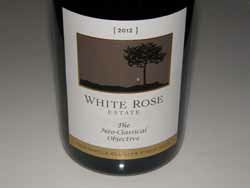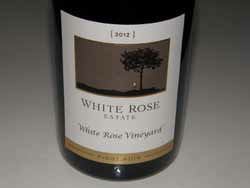Winery of Year: White Rose Estate
I wrote enthusiastically about White Rose Estate earlier this year in the PinotFile: www.princeofpinot.com/article/1524/ and readers should refer to this for additional coverage.
Greg Sanders is the mind behind White Rose Estate and the innovative wines produced here based on a “Neo-
Classical Objective.” Greg bought the 10-acre White Rose Vineyard in the Dundee Hills in the summer of
2000. Having found satisfaction as the owner of a moderately large manufacturing company in Los Angeles,
Greg had begun to look for a different pursuit that offered an emotional connection and found it in wine. He
embarked on an exhaustive exploration of Pinot Noir wines, beginning with ones from California, then
Burgundy and Oregon. He tasted all the wines from the established labels and studied them in depth to learn
what made them special and what allowed the better wines to improve with age. Eventually he arrived at his
“aha” moment, and decided the key was an old vine vineyard.
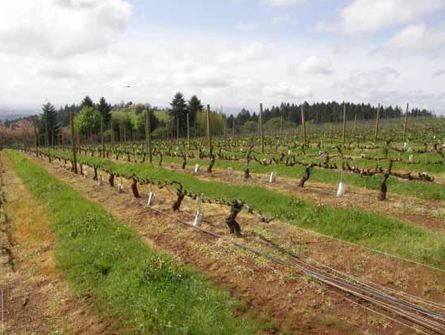
White Rose Vineyard had been planted to Pommard clone on its own roots between 1978 and 1982. The
photo above shows the established vines and new inter plantings in 2014. The east-southeast-facing vineyard
planted in volcanic Jory soils is well placed with prominent producers such as Archery Summit, Domaine
Serene, and Domaine Drouhin Oregon located nearby. The vineyard sits at 879 feet elevation and its location
provides an extended growing season that lends itself to harvest in late October. This allows for slow phenolic
development, balanced sugars and acids, and mature stems. Because of the resulting quality of the grapes,
Greg has called his vineyard, “One of the ten best vineyards in the New World.”
An adjacent 4 acres were acquired in 2009, planted to Dijon 115 clone grafted to American rootstock, and
named the Guillén Vineyard after Jesus Guillén who has managed the White Rose Vineyard since 2002, and
his son, also named Jesus Guillén, who is Greg’s assistant winemaker. Greg also sources fruit from a number
of the Willamette Valley’s top growers in the Yamhill-Carlton District, Dundee Hills, and Chehalem Mountains
appellations.
What is particularly impressive about Greg is that he is a self-taught winemaker (he prefers the term,
“producer”) who made his first wine in 1999 and his first commercial White Rose Vineyard Pinot Noir in 2001.
His winemaking expertise has evolved slowly over the past 13 years tied to the emotional connection he has
with wine. The culmination of his efforts led to the term which summarizes his goal, “The Neo-Classical
Objective,” first coined in 2011. This encompasses a highly innovative approach among Willamette Valley
vintners and is somewhat polarizing in its theory. Greg does not consider it revolutionary, however, since it is
soundly based in Old World winemaking techniques.
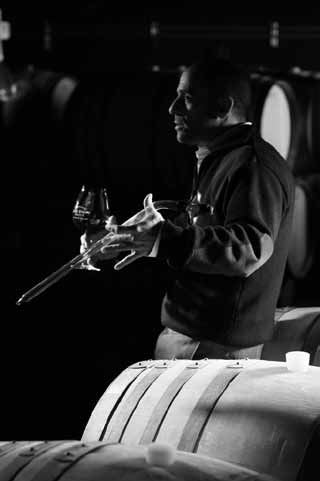
There are two parts to The Neo-Classical Objective: the “why” and the “how.” The “how” is the simpler of the
two parts, while the “why” is the impetus but more difficult to elucidate. Let me start with the “why” first. Simply
put, neo-classical refers to an alternate presentation of wine that elevates “pinotnoirness” above
everything else. The word “classic” refers to the many presentations of pinotnoirness over multiple
generations, while the “neo” refers to Greg’s contemporary adaptation.
The first requirement to achieve the neo-classical objective is to have vines old enough to make a wine that is
age worthy. There must be enough phenolic and tannin components to outlast the process of oxidation over
time. Tannins cannot be overriding initially as the wine will be austere initially, requiring years to oxidize, often
reaching an acceptable level at the time the phenolics (fruit flavors) have dissipated.
The second requirement is that the vineyard must be in the correct location, produce quality fruit, and be
subject to the proper temperature such that the resultant wine can achieve a sense of pinotnoirness. In the
classic sense, the grapes should reach a state of crispness and freshness, preferably with cherry, raspberry
and blackberry flavors. Greg gives the following analogy. If you randomly pick nine cherries and put them in
the palm of your hand, three will be dark and concentrated (very ripe), three will be crisp and fresh, and three
will be lean and tart (under ripe). The most desirable cherries for a classically driven Pinot Noir are the crisp and fresh
ones. As a corollary, the time of the picking decision is critical.
The “how” refers to Greg’s current approach to handling the fruit, skin and seed tannins both in the vineyard
and in the winery. Too little tannin and the wine will not last, and too much tannin will produce an edgy wine
initially that will need years for the tannins to resolve. In past generations, the tannins were often
overwhelming initially, something Greg avoids completely. The ultimate objective is to craft a wine that is
good from day one, yet will undergo a metamorphosis over time, not becoming necessarily better, but
different.
Ideally, Greg would prefer that much of the skin tannins oxidize away on the vine at the same time as
the grape phenolics reach ideal ripeness. Tannins are antioxidants so that as they diminish, the increased
available oxygen can ripen the phenolics. Invariably, some tannin remains at harvest, but Greg times his
picking so that he manage the associated astringency. In the cellar, punch downs are avoided to prevent
rupture of berries and the release of harsh, bitter seed tannins into solution (gentle punch overs are used
instead). Post-fermentation, the must is pressed off using a laborious old world basket press. that avoids
breakage of seeds and stems. In addition, post-fermentation maceration is minimized, again to avoid
extracting too much additional tannin. As previously emphasized, seed tannins are an anathema because they take so long to oxidize that the
wine is left with little enjoyable fruit.
Once Greg’s wines are in barrel, the process is routine. The wines are typically aged for 16 months in a low
percentage of new French oak barrels, racked once after malolactic fermentatiion, and then again just before
blending. They are bottled unfined and unfiltered.
PInot Noirs produced by Greg from old vines in the neo-classical objective mode, are fermented 100% whole
cluster. He is not the least bit worried about the stems, only the flavor, phenolic intensity and tannins. In some
years, tannin management is not ideal, and some mild herbaceous character may creep in, which may not
appeal to all Pinot Noir drinkers. Still, Greg is undaunted, for the nuances, texture, haunting aromas and
flavors, and age ability associated with whole cluster fermentation are too desirable in his opinion to think about
pursuing another winemaking tact.
In summary, to achieve the neo-classical objective of pinotnoirness and age ability and present the varietal in a
manner such that it has the greatest potential to generate an emotional connection to the wine:
(1) Farm on old vine Pinot Noir vineyard planted to quality clones or selections appropriate for the site.
(2) The vineyard must be located in the proper microclimate as growing temperatures dictate success.
(3) Pick the grapes at precisely the time of ideal crispness and freshness and modest tannic astringency.
(4) Gently handle the fruit in the winery with efforts to avoid excessive extraction of tannin, particularly seed
tannin
(5) Use 100% whole cluster fermentation.
(6) Press the must manually and gently with a basket press.
(7) Minimize new oak.
Over the past 13 years, Greg has expended considerable effort in improving the grounds of his estate property, the
tasting room, and the winery, so they will connect with visitor’s emotions and the “White Rose experience.” The
tasting room is unique in that it has no windows to distract the visitor from the wine tasting. In the cellar, elaborate
mood lighting and uniform sanding of the barrels creates an intimate and engaging atmosphere.
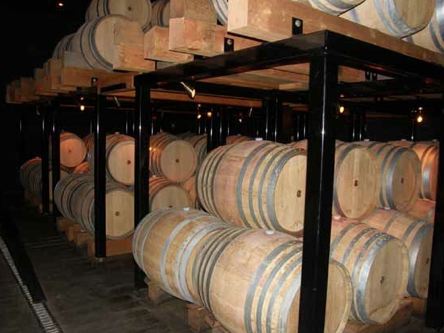
I tasted the following wines both at the winery and at home using my normal tasting regimen. I find the wines
display a haunting floral and exotic spice aroma and flavor associated with the high percentage whole cluster
ferments. For myself, and a number of other pinotphiles, whole cluster aromatics are like catnip for humans.
Herbaceous characters were extremely subtle to absent in these wines. The wines were elegant and sleek,
with non aggressive tannins, and commendable pinotosity (my term for Greg’s pinotnoirness). Oak is not
intrusive. All the wines could be thoroughly enjoyed now but will age.
Greg was excited about the 2012 vintage wines. He does not recall a vintage with so much potential. “The
2012 vintage was reminiscent of 2002 and 2008. It was warmer than average and certainly warmer than the
cooler vintages of 2007, 2010 and 2011, but cooler than the really warm vintages of 2003, 2006 and 2009.
While the wines are dense and rich on the palate, they are extremely well balanced with sufficient acidity.
Unlike wines from the warmest vintages where the fruit takes on an over ripe, stewed character, the wines from
2012 consistently retain a fresh, vibrant sense of fruit. Retaining this freshness is critically important to our
winemaking goals at White Rose Estate. I certainly appears that 2012 will live up the hype.”
I would encourage readers to experience these wines for their uniqueness. A number of Oregon wineries are
experimenting with some whole cluster inclusion in their ferments. Other than Broadley Vineyards, Cristom
Vineyards and Thomas Geerie Wines, I know of no other Oregon wineries so full committed to whole cluster
vinification.
White Rose Estate is located at 6250 NE Hilltop Lane in Dayton, Oregon. The tasting room is open daily from
11:00 to 5:00. Tours are available by appointment. The wines are sold through a mailing list and on the
website at www.whiterosewines.com. The Explorer’s Club offers unique bottlings. For example, in 2012, wines
were offered to Explorer Club members that were produced from different elevations. Different clonal bottlings
from the same vineyard will be offered from the 2013 vintage. The Neo-Classical Club offers members wines
that are collectable and age worthy.
2011 White Rose Estate “The Neo-Classical Objective” Willamette Valley Pinot Noir
13.0% alc., 416
cases, $80. White Rose Vineyard (35%), Vista Hills Vineyard (31%, 115 and 777)), and Murto Vineyard (34%,
Pommard, Wädenswil and 115). 100% whole cluster fermentation. 23 to 25-day skin contact. Aged 16
months in 9% new French oak barrels.
·
Moderate light reddish purple color in the glass. Nicely perfumed with
hi-tone aromas of spice, potpourri, pipe smoke and rose petal. Elegant, juicy and refreshing, with mid weight
flavors of cherry and smoky spices. The fine-grain tannins are modest and the wine finishes with a charming
burst of cherry fruit. The wine builds in flavor intensity in the glass over time and is much more giving the following day
from a previously opened and re-corked bottle. This relatively delicate wine delivers the neo-classical objective
of pinotnoirness.
Score: 92
2012 White Rose Estate Willamette Valley Pinot Noir
13.2% alc., pH 3.63, 1,094 cases, $40. A blend of 9
vineyards with multiple clones. 73% whole cluster fermentation. Aged 11 months in 11% new French oak
barrels.
·
Moderate reddish purple color in the glass. Appealing aromas of cherry, spice, red rose, oak and tea
leaves. Soft and smooth on the palate with a good grip and intensity featuring black cherry and raspberry fruits
caressed by supple tannins. A very good entry wine to sample the White Rose style.
Score: 89

2012 White Rose Estate “The Neo-Classical Objective” Willamette Valley Pinot Noir
13.6% alc., 428 cases, $80. After meticulously tasting
barrel samples blind before bottling, only vineyards that meet the neoclassical
objective for a given vintage are selected for this blend. White
Rose Vineyard (11%), Anderson Family Vineyard (17%), Guillén Vineyard
(28%), Lia’s Vineyard (22%), and Luciole Vineyard (11%). Pommard,
Wädenswil, 777 and 115 clones. 100% whole cluster fermentation, 16 to
26-day skin contact, aged 16 months in 14% new French oak barrels.
·
Moderate reddish purple hue in the glass. Lovely aromas of black cherry,
dark red rose petal, toasty oak, and exotic spice. This wine fills the
mouth with a suave fruit attack and holds on through a tenacious finish
that sports some fine-grain but minimally astringent tannins. The
middleweight flavors of black cherry, black raspberry and spice are sparkling and fresh. Significantly more
richness than the 2011 version of this wine. A superb wine that will be intriguing over time.
Score: 93-94
2012 White Rose Estate Guillén Vineyard Willamette Valley Pinot Noir
13.8% alc., pH 3.70, 188 cases,
$70. 9-day cold soak, 100% whole cluster fermentation, 21 to 22-day skin contact. Aged 16 months in 19%
new French oak barrels.
·
Medium reddish purple hue in the glass. The nose offers a range of aromas including
black cherry pie glaze, baking spice, potpourri and a hint of smoky oak. Plenty of robust fruit including black
cherries, red plums and blueberries accented with exotic spices. Soft and velvety on the palate with a good
spark of underlying acidity. Still has some unresolved tannins that will require short term cellaring.
Score: 92

2012 White Rose Estate Anderson Family Vineyard Willamette Valley Pinot Noir
13.0% alc., pH 3.71, 118
cases, $90. Vineyard is in Chehalem Mountains AVA. Self-rooted Dijon 115. 9-day cold soak, 100% whole cluster fermentation, 26 days total skin
contact, aged 16 months in 10% new French oak barrels.
·
Moderately dark reddish purple color in the glass.
Aromas of black cherry, dark red rose and cardamom spice lead to a mid weight + palate of dark stone fruits
embellished with delicious spice. The wine is long and silky in the mouth and finishes with spectacular
intensity with the fruit returning for several encores. The flavor is eye-opening and the texture is intriguing. Still
solid the following day from a previously opened and re-corked bottle.
Score: 94

2012 White Rose Estate Winemaker’s Cuvée Willamette Valley Pinot Noir
13.6% alc., pH 3.62, 257 cases,
$90. A special cuvée blended from favorite barrels in the cellar chosen by winemaker Jesus Guillén. A blend of
White Rose, Guillén, Vista Hills, Luciole and Red Hills vineyards. 6 to 9-day cold soak, 93% whole cluster
fermentation, 20-26 days of skin contact, aged 16 months in 9% new French oak barrels.
·
Moderately dark
reddish purple color in the glass. The nose is a knockout with bright aromas of black cherry, sarsaparilla,
smoky rose petal and spice. This wine is a textural masterpiece with waves of velvety goodness. The ripe
flavors of black cherry, black raspberry and spice really impress and are framed by a good grip of acidity and a
compliment of modestly firm, fine-grain tannins. The finish is incredibly long and vibrant. I like this wine more
the longer I sampled it. It was extraordinary the following day from a previously opened and re-corked bottle
showing an explosion of spicy fruit goodness and a very sleek demeanor.
Score: 94-95

2012 White Rose Estate White Rose Vineyard Willamette Valley Pinot Noir
12.9% alc., pH 3.77, 235 cases, $125. Low yields of 0.5
tons per acre due to poor set. Self-rooted Pommard clone. 6-day cold
soak, 100% whole cluster fermentation, 20 to 21-day skin contact, aged
16 months in 10% new French oak barrels.
·
Moderately light reddish
purple color in the glass. This is a very elegant and refined wine with
considerable freshness. The aromas of cherry, raspberry, wilted rose,
and spice jump from the glass. The core of cherry, raspberry and
pomegranate fruits is complimented by a vein of spice and leaf in the
background. The very slight herbaceous note adds a bit of savoriness
and is not at all off putting to me.This wine has more polished tannins
than the Winemaker’s Cuvée and slightly brighter tension. The peacock
finish is incredibly long and satisfying.
Score: 95-96
2008 White Rose Estate White Rose Vineyard Willamette Valley Pinot Noir
13.9% alc..
·
Moderate reddish
purple color in the glass. Aromas of black cherry, stem, roasted nuts, graham and chocolate. Mid weight +
flavors of cherry, black raspberry and cranberry with a touch of brioche, tobacco and cola. Intense on the
attack with a burst of cherry fruit, finishing with good length. The tannins are well-integrated and the texture is
very smooth. Plenty of lively fruit to last another five years easily.
Score: 91






